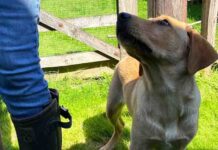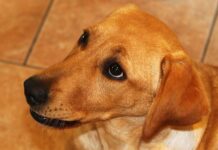Dog whistle training is the process of teaching your dog to display a specific behavior in response to a specific sound, the most common example being recall. The dog whistle is a brilliant tool for training your dog. When you call your dog’s name you sound a little bit different each time you give your signal. Your volume will vary, but so will the pitch and even tone of voice depending on how you are feeling at time. The dog whistle is utterly consistent, and makes the cue much clearer to your dog.
- The different types of dog whistle.
- Dog whistle training for pet dogs.
- Dog whistle training for disobedient dogs.
- The best dog whistles.
- Instructions for how to whistle train your dog.
A dog whistle can’t train your dog, but it can certainly help you get the job done. It will carry a long way on a windy day and be a recognizable and consistent sound that your dog associates with happy recalls. Starting with a puppy can be a lot of fun, but don’t worry if you have an older and rather naughty dog. This is your chance for a fresh start and a great way to get your dog bounding back towards you as you’ve always wanted.
Different types of dog whistle
Long before dog whistles were made in factories, people were whistling dogs. But not all of use have the enviable ability to create a piercing whistle without any kind of mechanical aid. So plastic or wooden dog whistles are very popular.
You have probably watched sheepdogs working with shepherds on TV and it’s certainly a wonderful thing to see dogs running from left and right, and sometimes dropping flat on their bellies, to whistle commands, often at hundreds of yards from their handler.
Modern shepherds often use a flat metal whistle which they place inside their mouth, to get the distinctive sound. Whereas gundog trainers tend to use the more familiar stick shaped whistle where you blow the end.
Dog Whistle Training for Working Dogs.
This kind of responsiveness to distance training has been bred into our Labradors too.
As working gun dogs Labradors must be able to follow whistle signals at a distance, especially the stop and recall whistle signals.
“Well, that’s all very well”, you may say, “but why does my Labrador need a whistle, he’s just a pet.” And that is a reasonable point. Let’s take a look at the pros and cons of whistle training.
Dog Whistle Training for Pet Dogs.
There are some obvious benefits to a dog whistle.
- Whistle volume
- Pitch and consistency
- Control over the signal
Whistle volume
A good whistle carries a long way, further than most people can shout, and especially in windy conditions.
Your whistle won’t get a sore throat if you use it too often. If you don’t have a very powerful voice, a whistle will certainly help you.
Pitch and consistency
When we are dog training, the cue or signals we give our dogs are easier for the dog to learn if they are consistent.
A whistle always sounds the same, even when you are angry, or tired, or just have a cold, your whistle will sound the same to your dog, and this consistency helps him to learn.
Control over the signal
Another benefit to the whistle is that you can prevent other people using it.
This can be helpful if you have small children who tend to devalue the dog’s name or recall command by using it over and over again, and at the wrong times.
One disadvantage of course to a mechanical signal like the whistle, is that it is possible to forget it!
Dog Whistle Training for Disobedient Dogs.
The main advantage of whistle training for many pet dog owners is that it offers them the chance of a fresh start with their training.
Selective hearing
Many of us get in a bit of a muddle with our first dog. We tend to mess up the training process and often end up with a dog that suffers from selective deafness or tends to ignore us and only come back when it pleases him.
Dogs like this have learned that “come here” means practically nothing at all. It might mean Dad is going to be a bit cross, but that’s about all.
The whistle on the other hand, has no meaning to many dogs – at least not yet. But it is a new and interesting sound. And a chance for you to retrain your recall and get it right this time – we’ll look at that below.
Will a whistle make my dog more obedient?
A whistle alone won’t make your dog more obedient, but consistent whistle training will, provided that you commit to it.
There is nothing about a whistle that makes a dog instinctively respond to it. You still have to train your dog to obey the whistle, just as you have to train him to obey your voice.
Are whistles harmful?
One question people sometimes ask me, is can a whistle harm a dog? Will it hurt his ears or harm his hearing?
Some whistles are extremely powerful, especially some of the USA competitive gun dog whistles that are designed to be heard hundreds of yards away even in strong winds.
It makes sense to avoid making very loud noises next to your dog’s ears. Having said that, the whistles I recommend for both pet dogs and hunting companions should not do your dog any harm at all provided you do not blow them directly at his ear.
Which is the best dog whistle?
I am going to tell you which whistles I prefer and why, but remember that this is a matter of personal preference. The main features you need in a dog whistle are
- Consistent sound – it shouldn’t vary too much when you blow it at different times
- Carries well – your dog should be able to hear the whistle clearly at distances of up to 200 yards
- Strong, rigid construction – you will drop your whistle and tread on it at some point.
- Washable – it goes in your mouth!
- Easily replaceable – if you lose it, you don’t want to have to retrain your dog to a different tone
- You can hear it clearly too – I am not so keen on ‘silent’ whistles as I like to be able to hear what I am blowing
If a whistle fits all these criteria, it’s probably just fine for you and your dog.
There are some very pretty whistles on the market, some of them hand made out of stag’s horn and other natural materials. But before you buy one, do make sure you can get another in exactly the same tone, because you will lose it. My own preference is for Acme gundog whistles*(paid link).

Why I love Acme gundog whistles
In the UK, almost all British gundog trainers, both competitive and non-competitive, use Acme gundog whistles. I have been using them for over forty years.
And though I have lost a few, I have never had one break or fail to work. I should add that Acme are not paying me to write this! The sound produced by an Acme whistle is consistent.
It carries well, and buying one is not going to break the bank. The acme comes in several frequencies, but the two most popular are the 210.5 (pictured above) and the 211.5*(paid link) ( pictured below).

Where can I buy a dog whistle?
The Acme whistles are widely available in the UK and increasingly in the USA as well. For many years the only color Acme whistles came in was black, but you can now buy them in a range of different colors, from lime green to baby pink.
You’ll also need a lanyard to hang the whistle around your neck*(paid link).

You can’t manage without one, the whistle needs to be right there near your mouth because you can never be sure when you might need it.
The lanyard is also handy for hanging your whistle up when you get home, though if you are retraining a naughty dog, I recommend you keep your whistle where only you can find it.
I have one hanging up with my car keys, another in my dog training bag, and a spare in my car.
Which frequency whistle is best?
I have used both Acme 210.5 and Acme 211.5 whistles, but I now stick to the higher frequency 210.5. You may hear people say that one frequency is for Spaniels and the other for Retrievers, but it simply doesn’t matter.
I have Labradors, Spaniels and Terriers and I use the 210.5 for them all. What is important is that you are consistent. Pick your frequency and stick to it.
How to use your dog whistle
Before you start training your dog, its a good idea to get the hang of using the whistle and making a distinctive sound with it.
Try blowing a single blast both softly and loudly. Use your tongue to break up the sound and tap out a series of ‘pips’ – its a bit like say ’t-t-t’ at the same time as you blow
Dog whistle commands.
Most of us focus on using the whistle to get our dog to come back to us. But there are lots of other uses for whistles too.
My hobby is sporting dog training and so I use my whistle to control my dogs at a distance.
I use a whistle command to turn my spaniels for example, so that they don’t get too far away from me (spaniels should work within gunshot range) and I use a whistle command to ’stop’ my dogs at a distance and get them to look back at me for directions.
A stop whistle is a useful cue for pet dogs too. Another whistle command I use is to tell my dog to put his nose down on the ground and start hunting for a retrieve.
This is useful if you want your dog to fetch something that he did not see fall.
How to use a dog whistle in training?
You can teach your dog to come to any kind of whistle blast that you can consistently make and repeat with your whistle
There are benefits to using standard whistle commands though. If you really get into whistle training and decide to take your training further at some point, you may want to teach your dog more than just a recall.
You might also want to attend training classes, in which case it’s quite helpful if everyone is singing from the same song sheet. Here are the three most basic, standard gundog whistle commands
- Recall a string of pips I use five pip-pip-pip-pip-pip
- Stop! A single blast peeeeeeep
- Turn two brief pips pip-pip
If you are certain that you never want to get involved in gundog training at any point, and if you only ever want use your whistle for recall, or teaching your dog to come, then you can use any of the above as a recall signal.
Your dog won’t care what your signal is.
Everything hangs on your commitment to teaching him to respond to it. And that is what we’ll look at below. Let’s just deal with a common concern first.
How to train your dog respond to the whistle
Whistle training is essentially the same as training with your voice, there is no real difference in technique, no special skills or tricks you need to know.
If your dog is disobedient, buying a whistle is a great opportunity to start again with your training and get it right, I’ll briefly explain the stages you need to go through below. For a more in-depth whistle training, you might like to join one of my online dog training courses.
The Core Skills course covers recall training using a whistle.
If you have already taught your dog to respond to your voice and he is fairly obedient, you can transfer that response to the whistle quite quickly.
Simple transfer from voice to whistle
Start by pairing the new whistle command or cue, with your old verbal one.
Always give the new cue first. So for example if you normally say ‘come’ when you want to recall your dog, and your new whistle recall signal is a string of pips, you’ll need to give the pips first followed by the word ‘come’.
Like this Pip-pip-pip-pip-pip “Come” – give your dog some great rewards when he arrives, food, a game, a retrieve etc.
Don’t rely on praise or petting. After a few repetitions, start to leave a gap of three seconds between the pips and the ‘come’.
Soon, your dog will start to come towards you before you say ‘come’ Make the pause bigger now, and drop the verbal ‘come’ as soon as the dog is coming to the whistle alone.
As with any new training, make sure you avoid distractions to begin with. That’s for good dogs. Now let’s look at naughty dogs, because whistle training is a great chance to start over
Starting over with dog whistle training
When you train dog to do anything to a whistle, there are five stages to work through. If your dog has got into bad habits (ignoring you)
You need to start at stage one, and work through to stage five with a brand new command. That’s your whistle. Here are the five stages
- Get the behavior
- Pair the behavior with your whistle
- Teach your dog to respond to the whistle
- Proof the response against distractions
- Maintain the response to the whistle
Many people fall down by trying to begin at stage three. Let’s look at an example.
Training your dog to come to the whistle
Dogs learn much faster if the signals you give them have meaning.
It is much easier to teach your dog to come to your whistle, if he already knows that the whistle means ‘run to me’
The way he learns what the whistle means is by hearing the whistle when he is already running towards you.
That’s what Stage Two is all about.
Stage two – a new language
In stage two we introduce the whistle not as a cue, not as a command, just as something that happens when he is running your way. This is essentially about learning a foreign language.
About understanding that ‘pip-pip-pip-pip-pip’ is just another way of describing the act of running back to your best friend. But first you need to get him running after you – which brings us to Stage One Stage one – loving that recall Stage One is all about creating a dog that enjoys returning to you.
This has to come first, and the only way to have a dog that really loves running up to his owner, is by reinforcing that behavior with a powerful reward.
A lot of people struggle with this because they think a dog should come out of duty or respect or love. But I can promise you that neither duty, nor respect, nor love is going to help you when your dog is three hundred yards away and is having to choose between returning to you or playing with another dog.
Only a trained response is going to do that.
And to train an automatic response we must reward the behavior we want, or punish the behavior we don’t want.
Most of us don’t want to use punishment nowadays, and in any case, it is very difficult to punish a failed recall, so reinforcement is the way to go. You can find out much more about all this at the Dogsnet Training Center.
‘Get it’ and ‘Pair it’ first
Remember, before you start to ‘teach’ a response you need to ‘get’ the behavior and ‘pair’ the behavior
1. Forget about commands. Just get your dog running after you and keep on surprising him with great rewards every time he reaches you. Get him running after you by acting silly, get his attention, whoop and wave your arms about, and run away from him. Keep those rewards coming. And stop giving him commands. Do this well away from any distractions.
2. Once your dog enjoys running towards you, start blowing the whistle when he is on his way and has almost reached you. When you are out with your dog and he checks in with you, blow the whistle as he approaches. It still isn’t a command. This is the pairing stage. Then head over to teaching my dog a basic recall for the rest of the training process.
We’re going to finish up here by taking a look at whistle training for puppies
Whistle training for puppies
People often ask me at what age whistle training can start. Should you teach a puppy a whistle recall first for example, or a verbal recall then a whistle?
I have done this both ways and I can honestly tell you it doesn’t matter.
One at a time
I think it is best to choose either a verbal cue, or a whistle cue and get the puppy responding well to that before teaching the other.
And many people will want to start with a verbal cue because they don’t want to be worrying about wearing a whistle in the house during those early weeks when a puppy is small.
Mealtime whistles
However, one thing you can do, to build a great association between the whistle and a pleasurable experience, is to blow your recall whistle gently whenever you feed your pup.
If you do that four times a day for the first month, he is going to be a big fan of the whistle before you even start training.
Affiliate link disclosure: Links in this article marked with an * are affiliate links, and we may receive a small commission if you purchase these products. However, we selected them for inclusion independently, and all of the views expressed in this article are our own.
The Labrador Site Founder
Pippa Mattinson is the best selling author of The Happy Puppy Handbook, the Labrador Handbook, Choosing The Perfect Puppy, and Total Recall.
She is also the founder of the Gundog Trust and the Dogsnet Online Training Program
Pippa's online training courses were launched in 2019 and you can find the latest course dates on the Dogsnet website




















While I don’t have either a gun dog or a lab, I found your article an excellent read. I have a 4 y.o. Sheltie that I got about a year ago, and though fairly well trained, his recall needs work. Within just a few minutes of using the whistle as you directed, he’s already responding better. Thank you, thank you, thank you! Can’t wait to see what else I can do with my herding/agility dog!
Hi Pippa,
I was so happy to start training my 20 month old lab to the whistle. I started him indoors, pairing the whistle with his coming toward me. He’s scared to death of it! When I blow it lightly, he runs and hides under the table!
I have tried associating it with positive things like cooked chicken. He just keeps hiding. Any thoughts? 🙂 I suppose patience and keeping at the positive associations are my best options, but I’d take some hints as well!
He has a good recall for a young dog, but as he gets bigger and stronger, I am thinking I want a recall tool that will break through his concentration and drive. Thank you!
[…] the same every time, your dog can get used to a very consistent, emotionless noise, according to Thelabradorsite.com. If you have a big family and multiple voices are telling the pup to “sit,” he can become […]
We recently acquired a black lab puppy, Bob, our first ever puppy. The week before we got him, we read your books cover to cover & from day one followed your tips & advice. I started formal puppy training classes last week & the trainer asked how many puppies I’d trained – Bob was that beautifully trained!
We’re very grateful to you indeed.
Hi Pippa. Firstly thank you for the knowledge you’ve shared in your books and websites, they are immensely helpful and have given me the confidence to train a puppy from scratch.
I have a 10 week black lab which ultimately I would like to take rough and driven shooting. I’m about to invest in a whistle (probably acme 210.5) and have one concern and that is at the end of a drive there is a cacophony of whistle blowing from the various pickers and beaters as they work their dogs. How does a dog know which whistle to listen to and which to ignore if we assume that other handlers will also have an acme 210.5 for example?
Your thoughts on this would be most helpful.
Hi Geoff, people often worry about confusion with other whistles, and although it can be a problem occasionally, for the most part dogs can tell which is their owner. We all blow slightly differently. Lots more on whistle training for gun dogs here http://totallygundogs.com/?s=whistle
Dear Pippa,
I am reading your posts regularly for some time now and find them very helpful and resourceful. I highly recommend your sites also to my dog loving friends.
With my Brittany spaniel Fija, I already train with my friend’s retriever club (started as a fun gundog activity), where I use three “retrieving” commands:
-come: two short pips; pip-pip
-sit: one long pip; peeeeeeep
-search: I use this when Fija gets really close to the dummy to let her know she needs to start searching (useful for blinds, mainly); short pip followed by decreasing sound.
-and verbal and hand commands for directions: “back”, “left”, “right”, the first one starts from heel position, while the other two start from Fija facing me.
Now I am starting a gundog course for HPRs to obtain breeding license and I got stuck at the point where I need to introduce new whistle commands.
The thing is that the instructors at HPRs’ and at “retrievers'” use same whistle commands for different tasks (descending sound means ‘search’ at “retrievers” while it means ‘down’ at HPRs). Besides, instructor at HPRs’ uses different type of whistle from that at “retrievers'” and I do not want to change the whistle nor the whistle commands.
I should also mention that I do not want to differ the two activities to the point where I need to change the whistle, I just want to add some new commands. I already have some other extra sport activities and I use the significant ritual and cue word so that she knows exactly what is the mission.
Since you are familiar with the whistle I use – acme 211.5 – and have very versatile work with your dogs I would really appreciate it if you could help me with some ideas for new extra whistle commands. I will need to teach Fija 2-3 new whistle commands:
-turning
-down (lie down with head touching the ground).
-and, I suppose, some kind of command to get Fija out of down position and fetch the shot bird/dummy. For now I only use verbal “get it” to get the ball. I have watched videos on quartering work with springer spaniels and they use whistle command (short blow) to cast, which I find really useful and would like to use for this purpose. Unfortunately, the short pip command is used at HPRs to change the directions. Luckily, I am at the phase of making up the new commands but the downside is, I have no ideas what kind of whistle commands I should use.
Looking forward to your reply!
With kindest regards from Slovenia,
Spela
Any one know of a horn used like a whistle? My brother no longer can blow a whistle due to throat cancer. He has and loves his dogs any suggestions.
Hi Nan, some kind of electronic whistle would be ideal wouldn’t it, but I can’t find anyone that makes one. A bell might work, or even an air horn though I think they are pretty loud.
I don’t normally like them (partly because they don’t identify the location of the person calling the dog) but perhaps in this situation a collar with a beeper or vibrator might be another solution. I’d be interested to know if you or anyone else thinks of a good solution. Good luck to your brother 🙂
Go to tideridersports.com. they have an electronic whistle that may be what you’re looking for.
Im reading Total Recall, its brilliant. I have an 8 month old lab she is very good at coming back if there arent other dogs about. I think she may occasionally have selective hearing so I want to nip it in the bud! We are working through the proofing exersices, so far doing well. 🙂
Glad you like the book Caron, good luck with your training
Hi Pippa
I have a Manchester Terrier puppy who is deaf in one ear & can’t distinguish what direction sounds come from. I’m training him using hand signals rather than voice commands but getting his attention when he’s several meters away & not looking at me is tricky. I am thinking of using a whistle as a signal to ‘look for mom’ so I can then give hand signals. How do you suggest I teach it?
Thanks for your help!
Alison
“Always give the new cue first.”
I have always done is the opposite way round with perfect success.
Use the cue they know first (e.g. COME!) then associate the whistle as a secondary cue alongside one they already know.
Why so insistent it has to be the other way round?
The new cue is given first followed by the old cue, and gradually the time gap between the two is increased to give the dog a chance to respond to the new cue, before the old cue is given.
There is an explanation in the article 🙂
Since my dog shies away at the whistle, this is somethiing I’m having a bit of trouble with. If I cue him with the whistle first, he stops dead in his tracks and is reluctant to come on the known command. If I cue him with ‘COME” first, and then follow it with the whistle, again he stops in his tracks and i have to call him again. I’ve tried changing the pitch, but he is not a fan of the whistle at all.
Hi, Thank you for the great puppy video on whistle training. I have since 12 days an Australian labradoodle, who is 12weeks old and he already is great in listening to the come as well as whistle. I fed him shortly tiny pieces of plain roasted chicken after blowing the whistle. He then started automatically to follow me and paired action with whistle. I did this for a week and one day when he ran after one of our rabbits I used whistle in despair and he came to me in an instant. Luckily I had a treat ready! I shall keep working on proofing and make most of my time to train recall before he gets older. Thank you for the tips and I carry whistle around my neck all the time….
Forgot to say he was proofed in this place and always returned even with other dogs playing with him and many people.
I have used a whistle for my two Labradors since they were puppies (now 4 years old) it is the most reliable method for me because with two dogs to recall they both respond to the same whistle sound I use. So successful in fact my friend who has 10 month old choc is now using one as hers responded when I recalled my dogs! How lucky is she, instant recall without the training as my choc is his best friend!
Hi pippa used you book Total Recall to train my puppy on the Whistle he was great always came running back turning on a sixpence went for a walk with my daughter and wife my daughter was way in front and he was ahead with her blew my whistle five pips he came running back stopped about 10ft away looked back towards my daughter so I called him at that he about turned and ran back to my daughter he done this twice so placed him back on at 50ft line and increased the reward.
Any better advice at depreciated have started to read your book again as something has not sunk in obviously. Forgot to say he is 7 months now and his under caridge has just dropped but I know it’s in the training and need to keep on top of it.thanks. Barry.
Great article.
I’m reading your book but shall by a whistle too… need to get my dog back!
Thanks Sue,
Good luck with your training 🙂